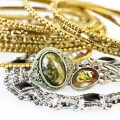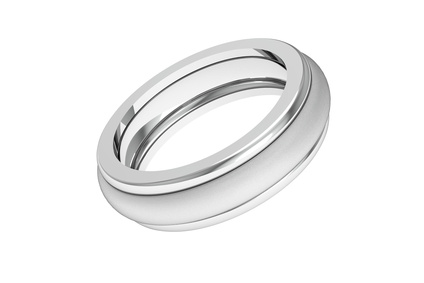One of the most common dilemmas people face when shopping for a ring or other jewelry is what it should be made of. This question is especially pertinent when choosing a material for the piece’s setting, which needs to hold your gemstones securely. When making this choice, people often debate between platinum and white gold.
Let’s see how platinum and white gold compare and what their pros and cons are when used in rings and other jewelry.
Platinum Facts

Platinum is one of the most durable metals you can choose for rings.
Platinum is a precious metal that is relatively malleable and heavy. It is one of the most expensive metals used in jewelry, and rings made of it cost significantly more than ones made of gold.
Platinum is also resistant to corrosion and does not tarnish.
White Gold: How It Is Made
White gold is much cheaper than platinum. It is made from yellow gold mixed with other metals to make the resulting alloy harder and give it a white color.
Most white gold is covered with rhodium plating, which makes the color of the otherwise yellowish material pure white.
Durability: How Does Platinum Compare to White Gold?
Platinum is one of the most durable metals you can choose for a ring. While it does scratch, platinum does not wear out and erode over time as easily as gold. Although platinum can bend, it is harder to break, and this quality makes it a very good choice for ring prongs.
White gold is also pretty durable, but its hardness depends on its karat – the lower it is, the less actual gold the piece contains and the harder it is. Although higher-karat items tend to be softer because of the higher gold content, this is somewhat compensated for by the rhodium plating white gold is usually covered with. The top rhodium layer makes white gold harder and more durable.
However, keep in mind that although a platinum prong can be easier to bend depending on the alloy’s content, a white gold prong can be more brittle and easier to break.
It is worth noting that white gold will lose its rhodium plating over time and will have to be replated. In addition, white gold is more vulnerable to erosion caused by household chemicals such as chlorine. Platinum, on the other hand, does not have such issues.
How to choose:
Platinum is softer but stronger. If you go with platinum, your ring’s structure will be more robust, and its parts, such as prongs, will not be easy to break.
Pick platinum for rings that you will wear often and want to last longer. While platinum will scratch, those scratches do not result in lost metal but rather in displacement of the material.
Choose white gold if you want to save some money, especially if you think that your ring will not be exposed to much stress. If price is an important consideration, then pick white gold for a ring that you will not wear very often. This way, you will pay less upfront than for a platinum ring, but you won’t need to pay often to have the ring replated with rhodium when it wears off..
Color
Although both white gold and platinum are white, there is some difference in their appearance, especially when time passes. Platinum tends to scratch and develop a patina that makes the metal lose its shine and take on a grayish, matte look.
If you want to restore the luster of your platinum jewelry, you will have to have it polished. However, if you like the patina, platinum will be a good fit for your taste.
White gold does not develop a patina, but its rhodium plating wears out with time, exposing the jewelry’s lower layer, which has a yellowish color.
So, if you want to keep your white gold ring shiny and white, you will need to take care of it by having its rhodium plating restored periodically.
Click here to take a look at the newest and most popular gold jewelry.
Platinum vs. White Gold: Allergies
Platinum is hypoallergenic, meaning that it won’t give you a rash or skin irritation.
It is true that some platinum alloys may contain nickel, to which some people are allergic, but the nickel content in those alloys is so low that it is very unlikely to cause an allergy.
White gold alloys can sometimes contain nickel in a concentration high enough to cause a rash.
However, if your ring is rhodium plated, the plating will keep the nickel from coming in contact with your skin.
Problems start to arise when the rhodium wears off and the nickel-containing layer is exposed. In such a case, you will need to have the piece replated as soon as possible.
Buying recommendation: If you are concerned about allergies, then you can either pick a platinum ring or go with a white gold ring that is nickel free.
Weight: Does It Matter Which Is Heavier?
In general, a ring made of platinum is heavier than a comparable ring made of white gold.
This might not seem like a big deal, but weight can become more of a factor if you are getting a bigger ring, for example, especially if a relatively large diamond is set in it.
So, before you buy, think about how a platinum piece would feel versus a white gold one when worn for an extended period of time.
Price: Platinum vs. White Gold
Although platinum has superior durability, the high cost of this metal is one of its biggest downsides.
White gold has its pros and cons, but when it comes to making a purchase decision, think about how much more you are willing to pay for platinum’s advantages.
If you are inclined to choose white gold, though, be sure to factor in the cost of replating the piece with a new layer of rhodium every 3-5 years.
White Gold vs. Platinum For Ring Prongs
White gold is a popular material for making prongs, even when the rest of the ring is made of yellow gold, but why is it so?

White gold is a popular material for making prongs.
There are two main reasons jewelers use white gold prongs:
1. Color: Let’s say you have a diamond and want it set in a yellow gold ring. If the stone is colorless or nearly colorless, yellow gold prongs would make it look tinted in yellow, whereas white gold ones would blend nicely with its color. However, yellow tinting is not such a big deal with low-grade diamond colors, which look yellowish anyway.
Here you can see a selection of diamond rings that can be ordered in white gold or platinum.
2. Durability: Since metals such as yellow gold or silver are very soft, prongs made of them wear thin faster and break more easily. White gold, however, is more durable. It is made of yellow gold mixed with other metals to make it harder, and it is plated with rhodium, which gives it additional luster and protection.
Despite its durability, when a white gold setting is exposed to chemicals such as chlorine, which can be found in tap water and some detergents, the prongs can get damaged and become more likely to break.
Although platinum prongs are nearly impossible to break, they can still bend and make the stones in your settings loose. Sometimes, platinum prongs may be easier to bend than white gold ones, and this propensity depends on the technology used to form prongs out of platinum.
A point that is not often mentioned is the way white gold and platinum change in appearance when they wear. You should keep in mind that platinum does not stay shiny forever, and although it is durable, it does scratch, becoming duller with time. White gold, on the other hand, keeps its luster over time as long as its rhodium plating is not worn off; when that happens, you will need to have it replated.
The Bottom Line: Choosing Between White Gold and Platinum
So, how should you decide between white gold and platinum?
For the additional money you pay for platinum, you get greater durability; you won’t need to worry about broken prongs, but you will still need to check regularly whether some of them are bent.
White gold is cheaper and is, in general, pretty durable as long as you keep it away from chlorine and remove your ring when washing or doing any housework.
Be sure also to consider that platinum won’t look as shiny as white gold after some time and decide for yourself whether that difference is really important to you.














